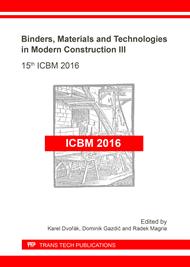p.106
p.111
p.118
p.123
p.129
p.134
p.139
p.145
p.154
Influence of Degradation of Surface Layer of Light-Weighted Panels on its Sunray Absorptance
Abstract:
Sandwich cladding panels, based on PUR, PIR or similar foams, are frequently used for insulation of all types of assembled industrial, store and sporting halls, as well as of commercial and administrative objects, namely for those with controlled interior temperature, and represent an advanced and modern building element. However, favourable properties of such panels are limited by the long-time degradation of the coating layer, caused by various climatic influences, as intensive sun radiation, wind, rain, frost etc., resulting in the modification of surface emissivity. Increased thermal absorptance of panels can be observed namely on south-oriented walls. This paper pays attention to the surface treatment of panels, comparing their physical emissivity in the range of wavelengths of sunrays, depending on the measure of their degradation, due to the amount of absorbed sun radiation. The significance of such influence is quantified, utilizing the well-considered measurement methodology.
Info:
Periodical:
Pages:
129-133
Citation:
Online since:
October 2017
Authors:
Price:
Сopyright:
© 2017 Trans Tech Publications Ltd. All Rights Reserved
Share:
Citation:


